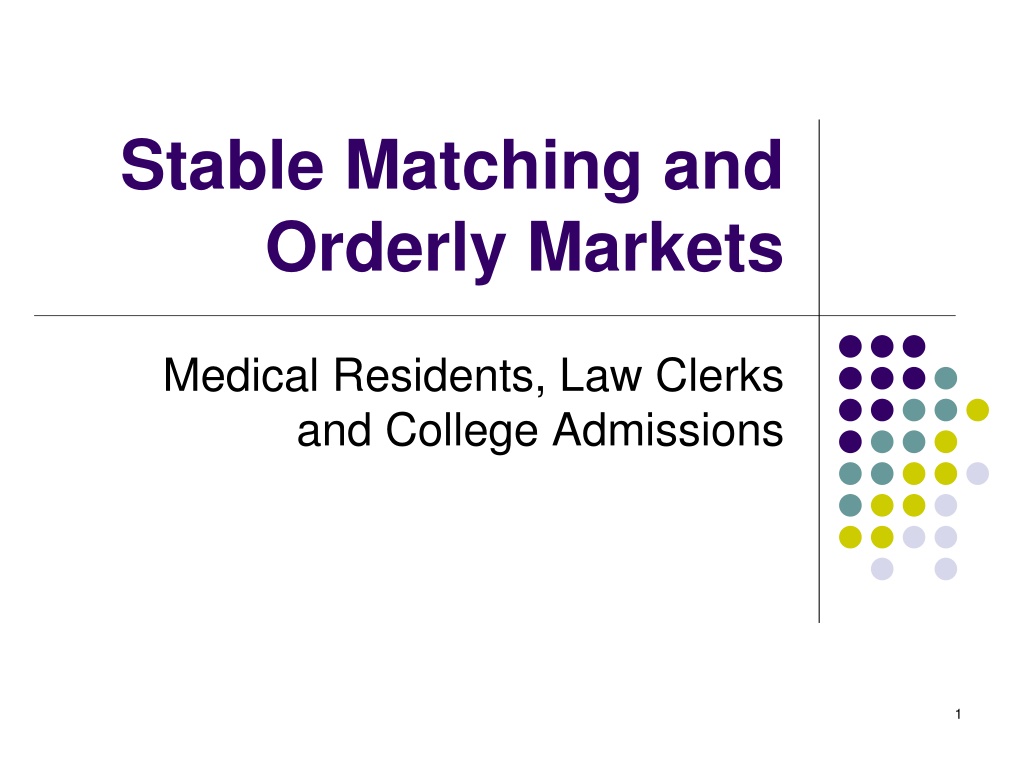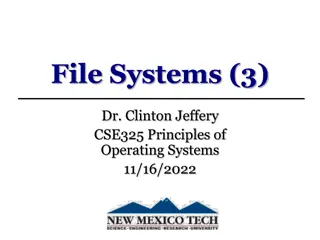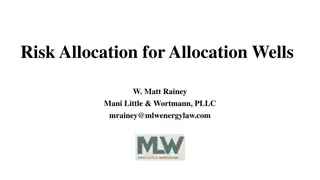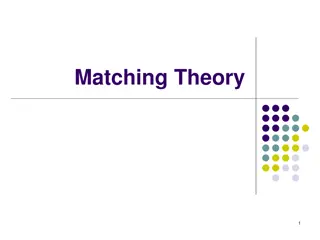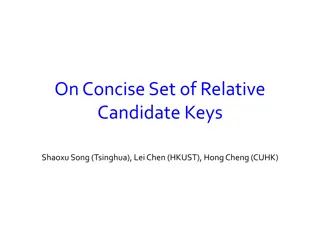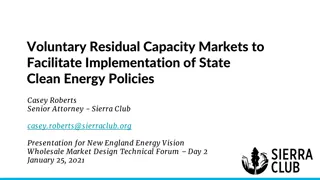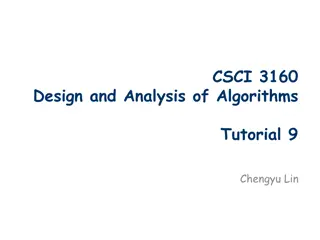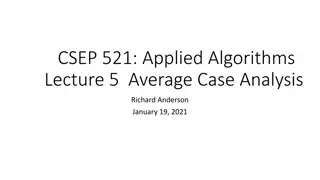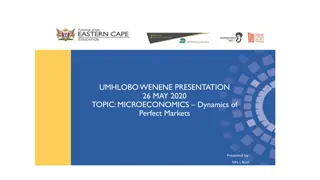Understanding Stable Matching and Orderly Markets in Various Allocation Systems
Exploring the concept of stable matching and orderly markets in different allocation systems such as medical residencies, law clerk placements, and college admissions. From theory to practice, the history of the National Residency Matching Program (NRMP) to centralized clearinghouses, the importance of stability, and efficient market outcomes are discussed. The process of priority matching and the impact of design choices on market efficiency are also considered.
Download Presentation

Please find below an Image/Link to download the presentation.
The content on the website is provided AS IS for your information and personal use only. It may not be sold, licensed, or shared on other websites without obtaining consent from the author. Download presentation by click this link. If you encounter any issues during the download, it is possible that the publisher has removed the file from their server.
E N D
Presentation Transcript
Stable Matching and Orderly Markets Medical Residents, Law Clerks and College Admissions 1
Todays Class Last time: introduced the basic model of two- sided matching and idea of stable matching. Today: discuss organization of matching markets in practice, using examples. Clearinghouses and decentralized markets Problem of unraveling in matching markets Forces that lead matching markets to clear in ways that are more or less orderly and efficient. 2
From Theory to Practice Study of matching started as pure theory: first by David Gale and Lloyd Shapley (1962) who introduced DA algorithm, then others, eg Stanford prof Donald Knuth. In 1984, Al Roth made a surprising discovery: Since the 1950s, US hospitals have used a clearinghouse to assign graduating medical students to residencies. Students apply and interview at hospitals in the fall, then students and hospitals submit rank-order preferences in February. A computer algorithm is used to assign students to hospitals, and matches are all revealed on a single day: match day. Roth realized that the doctors has independently discovered and were using exactly the Gale and Shapley DA algorithm! 3
History of NRMP History turns out to be illuminating Into the 1930s, medical students found residencies through a completely decentralized process. But there were problems: students and hospitals made contracts earlier and earlier, eventually in second year of med school! Hospitals decided to change the system by adopting a centralized clearinghouse. National Residency Matching Program (NRMP) adopted, after various adjustments in 1952. System has persisted, though with some modification in late 1990s to handle couples and some recent debate about salaries. Why might a centralized clearinghouse be useful? And how might the design of the clearinghouse matter? 5
Stability and Orderly Markets Some hypotheses to consider: Centralized clearinghouse can lead to more orderly market than decentralized (eg clinical psychology) Designing a clearinghouse to achieve a stable match might discourage re-contracting, or pre-contracting. How could one test these hypotheses? Compare DA to alternative matching process. Compare centralized markets to decentralized. Ideally, with some sort of experiment (lab? natural?) 6
Priority matching Men and women submit their preferences. Each man-woman pair gets a priority based on their mutual rankings. Algorithm matches all priority 1 couples, takes them out of the market. New priorities are assigned and process iterates. Example of priority assignment: Assign priority based on product of the two rankings, so that priority order is 1-1, 2-1, 1-2, 1-3, 3-1, 4-1, 2-2, 1-4, 5-1, etc Algorithm implements all top-top matches, then conditional top-tops, etc. When none remain, look for 2-1 matches, etc. Compare this to DA: will priority matching lead to a stable match? Should people be honest or strategic about their preferences? 7
Example Preferences of men and women m1: w1 > w2 > w3 w1: m2 > m1 > m3 m2: w2 > w3 > w1 w2: m1 > m3 > m2 m3: w2 > w1 > w3 w3: m1 > m2 > m3 Find the unique stable matching. Find the outcome under priority matching with order 1-1, 2-1, 1-2, 1-3, 3-1, 2-2, 2-3, 3-2, 3-3 8
Priority Matching Example Three men, three women with rankings m1: w1 > w2 > w3 w1: m2 > m1 > m3: m2: w2 > w3 > w1 w2: m1 > m3 > m2 m3: w2 > w1 > w3 w3: m1 > m2 > m3 Unique stable match: (m1, w1), (m2, w3), (m3, w2) Priority order is 1-1, 2-1, 1-2, 1-3, 3-1, 2-2, 2-3, 3-2, 3-3. No top-top matches, first match is: (m1, w2). Removing m1, w2, top-top match is: (m2, w3) Which leaves: (m3, w1). Not stable, and m1 could list w2 last and get w1.. (check!). 9
Failure of priority matching Roth (1991, AER) studied residency matches in Britain, which are local and have used different types of algorithms --- a natural experiment . Newcastle introduced priority matching in 1967. By 1981, 80% of the preferences submitted contained only a single first choice. The participants had pre-contracted in advance! This is the type of market unraveling that plagued the US residency market prior to the NRMP. We ll have more to say about unraveling later. 10
Success of stable mechanisms Market NRMP US Medical Specialties (about 30) UK Residency matches (Roth, 1991) Edinburgh Cardiff Birmingham Newcastle Sheffield Cambridge London hospital Canadian lawyers Pharmacists Reform rabbis Algorithm DA DA Still Used? yes yes* DA DA yes yes no no no yes yes yes* yes yes Priority Priority Priority Priority Priority DA DA DA 11
Stability and Market Participation Starting in the 1970s, an increasing number of couples graduated from medical school. Typically couples want to be in the same city, but the DA algorithm doesn t account for this; it might put a husband in Boston and wife in Chicago. So many couples started to go around the NRMP to find positions where they could be at the same hospital match was threatened by a new form of unraveling. NRMP realized there was a problem and eventually asked Al Roth to re-design the match. 12
Couples: a problem! Couple c1,c2 and single student s Two hospitals, each hiring one student Hospital 1: c1, s Hospital 2: s, c2 Single student: H1, H2 Couple: (H1, H2) or nothing. There is no stable match! 13
Instability with Couples Preferences Assign one member of couple? Hospital 1: c1, s Couple will block Hospital 2: s, c2 Assign (H1,c1),(H2,c2)? Student: H1, H2 Couple: (H1, H2), H2 + s will block Assign (H1,s)? Couple + hospitals block Assign (H2,s)? s + H1 will block 14
Couples in the DA Preferences Round 1 Hospital 1: c1, s H1 c1, H2 s Hospital 2: s, c2 c1 rejects, s holds Student: H1, H2 Couple: (H1, H2), Round 2 H1 s, s rejects H2 Round 3 H2 c2, who rejects. End state: (H1, s) match. 15
Couples in the DA Preferences Round 1 Hospital 1: c1, s c H1,H2, s H1 Hospital 2: s, c2 H1 rejects s Student: H1, H2 Couple: (H1, H2), Round 2 s H2 H2 rejects c2 c1 withdraws from H1 End state: (H2, s) match. 16
Re-Design of the NRMP No clean solution to the couples problem. Student-proposing perhaps a bit better => switch from hospital to student proposing version of DA. What if DA algorithm doesn t find a stable match? Perturb the algorithm and keep going. Not guaranteed to find a stable match, but seemed to work in simulations (and large mkts). These theory-guided fixes brought couples back into the match, stopping the unraveling. 17
The NRMP as a Case Study NRMP is an unusual but illuminating design of a matching market because it is so organized. Motivation for moving to a clearinghouse was unravelling (i.e. disorderly operation) of decentralized matching. Design of the clearinghouse evidently quite important: systems with unstable matching seem to have fared poorly. Next, let s consider some comparable markets with different approaches to matching and see whether and how these insights might extend. 18
Law Clerk Market Students graduating from law school seek positions with federal or state judges (Avery et al., 2001). A similar story of unraveling: market for clerkships to start in July/August 2003 cleared in September 2001. Market is thin, fast and chaotic, with judges frequently making exploding offers with short deadlines. Attempts to enforce hiring dates and rules (there have been many) have not worked well. In March 2002, Judicial Conference agreed to a one-year hiring moratorium, with hiring for Fall 2004 to start in Fall 2003. Moratorium was okay, but the start date was tricky 19
Unraveling of Fall Deadline Open letter from Stanford Law Dean Larry Kramer, June 19, 2012 As you know, the Law Clerk Hiring Plan establishes dates in September before which federal judges are not supposed to interview or make offers to rising third-year law students. Law schools, for their part, are supposed to discourage students from applying before those dates and to discourage faculty members from supporting students who nonetheless do so. When the Plan was created, and for many years after, the vast majority of judges abided by its terms, providing order and equal access to federal judicial clerkships. In recent years, that order and access has eroded. Increasing numbers of judges the entire membership of some courts, some or many of the judges in most others have begun interviewing and hiring law clerks well before the Plandates. Law schools, understandably anxious not to disadvantage their students, have accommodated these early moving judges. Without making explicit or formal institutional announcements, schools have looked the other way while permitting or even tacitly encouraging faculty members to contact and correspond with early moving judges on behalf of their students. Put in other words, the Plan is not actually being followed, resulting in a process that is inequitable and unfair. Students who are in the know because they are members of the right student organization or on the right journal or have the right faculty mentor learn which judges are accepting early applications and get support. Those lucky enough to have connections to judges and/or faculty members are able to apply and secure clerkships, while others, less fortunate, are not. 22
Exploding offers I received the offer via voicemail while I was in flight to my second interview. The judge actually left three messages First, to make and offer. Second, to tell me that I should respond soon Third, to rescind the offer. It was a 35 minute flight. I had 10 minutes to accept I asked for an hour to consider the offer. The judge agreed; however thirty minutes later [the judge] called back and informed me that [the judge] wanted to rescind my offer. 23
Market Unraveling The residency and law clerk markets are two examples of markets that have unraveled clearing of the market has shifted earlier and earlier. Many matching markets, especially with fixed appointment dates, have suffered from this problem. Medical fellowships Judicial clerkships College admissions College football bowls High school prom NBA/NCAA basketball recruiting Baseball free agency Political campaigns/primaries We ve already touched on why this might happen. Does it create inefficiencies? How so? 25
Gastroenterology Fellowships Doctors completing residencies often continue training for 2-3 years as specialized fellows. Many fellowships, but not all, have adopted versions of the NRMP matching system. The gastroenterology fellowship is particularly interesting because in the mid-1990s the match collapsed, and only recently re-started. Opportunity to do a before and after study of the effect of a centralized clearinghouse in an entry-level labor market. 26
Collapse of GI Match Posts withdrawn (%) 1992 -- Posts in Match Percent Matched Applicants per position 1.8 377 97 1993 -- 399 94 1.6 1994 -- 369 93 1.6 1995 4 337 89 1.3 1996 5 298 75 0.9 1997 16 213 85 1.1 1998 44 99 78 1.5 1999 60 14 -- -- 27
What happened? Key event may have been 1996 study in JAMA stating that there are too many GI docs, and calling for 25-50% reduction in fellowships that programs then endorsed. Following this, both sides appear to have felt that they were on the short side of the market -- although it seems demand for positions did not actually fall off. After the match died, interesting changes Market became early and very rushed Matches were made locally 28
Some tentative conclusions Decentralized markets with fixed appointment dates can have timing issues that may create problems Employers and workers may have an incentive to jump the gun in order to ensure a match or a good match. Employers may be hesitant to leave offers outstanding, and may want to use exploding offers to rush decisions. The market can clear in a disorderly fashion so that participants end up with a relatively limited set of choices. These issue potentially can translate into inefficient matching, although we have not seen much evidence to quantify the benefits of an orderly market. 31
College Admissions College admissions in US is decentralized but organized in a relatively precise fashion schools often use common application & set common deadlines. Practice of early admissions is a somewhat controlled form of market unraveling. Students generally can target one school with an early application, and admission may or may not involve commitment to attend (early decision versus early action). Most selective schools offer early admissions - 30 of 38 most selective US universities, and 24 of 25 most selective liberal arts colleges. 32
The Early Admissions Debate Adoption of early admissions & controversy Large number of schools adopted early admissions in the 1980s- 90s, as admissions was becoming more competitive. Early admit rates can be double regular ones; EA perceived as unfair to less sophisticated students. Could there be benefits to early admissions? Allows students to communicate information & enthusiasm - a credible signal (Avery-Levin, AER). Potentially limits the number of applications students have to prepare and colleges have to evaluate (transaction costs). But there also is considerable evidence that schools face competitive pressure to use these programs. 33
Dropping Early Admissions? From the New York Times, February 24, 2011 Princeton and Harvard Reinstate Early Admissions By CATHERINE RAMPELL A real-life allegory on the perils of unilateral action: First Princeton tried to be the leader on grade deflation, but no one followed. Then Harvard and Princeton decided to end their early admission programs, on the grounds that they were unfair to economically disadvantaged students. Again, apparently few schools followed suit. [Quoting from the] Daily Princetonian: Tilghman explained that one consideration that played into the University s decision was that high school students would apply to other schools early even if they thought of the University as their first choice. 34
Congestion 35
Summary Matching market differ widely in their degree of organization and centralization. Centralized markets generally try to coordinate matching on a particular date, and even markets such as US college admissions have fairly set dates for application, admission and decisions. The specific design of centralized markets and ability to achieve stable outcomes seems important for their success.. The timing and orderliness of market clearing can be a major issue driving attempts to organize markets In many cases, markets have exhibited a tendency to unravel in a disorderly way, potentially creating inefficiencies. In some cases, an orderly multi-stage market may be an efficient way to transmit information and limit transaction costs. 36
